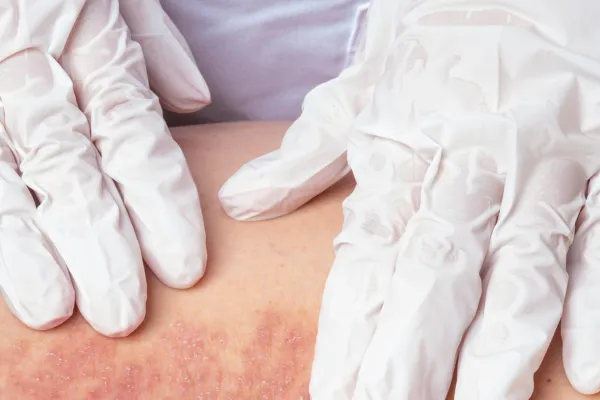About Arthritis
As the nation’s #1 cause of disability, arthritis affects nearly 60 million adults and 300,000 children. Over 100 types of arthritis and related conditions damage the joints and often other organs.
How can we assist you?
Helpful Tools for You

Who Should Handle Musculoskeletal Symptoms in Psoriasis Patients: Dermatologists or Rheumatologists?
A compelling debate took place at the annual meeting of the Group for Research and Assessment of Psoriasis and Psoriatic Arthritis (GRAPPA) in 2024. The central topic was whether musculoskeletal (MSK) symptoms in patients with psoriasis should be primarily managed by dermatologists or rheumatologists. With both specialties playing vital roles in the care of psoriasis patients, the discussion aimed to highlight the best approach for managing Psoriatic Arthritis (PsA) and related MSK symptoms.
The Rheumatologist’s Perspective: Prioritizing Early Diagnosis
Dr. Fabian Proft, a rheumatologist at Charité — Universitätsmedizin Berlin, advocated for rheumatologists to take the lead in managing musculoskeletal symptoms in psoriasis patients. He emphasized the importance of early and accurate diagnosis, particularly to distinguish between inflammation linked to PsA and other mechanical issues, such as athletic injuries. In his presentation, Dr. Proft underscored that advanced imaging techniques, like MRI, are vital tools to avoid overdiagnosis and overtreatment.
He cited the example of a psoriasis patient suffering from Achilles tendinitis while training for a marathon. Despite initial concerns that the pain was PsA-related, it was ultimately attributed to mechanical stress from exercise. Dr. Proft stressed that in such cases, careful assessment and imaging are key to ensuring accurate treatment.
The Dermatologist’s Response: A Collaborative Approach
Dr. Laura Savage, a consultant dermatologist from Leeds Teaching Hospitals NHS Trust, offered a different perspective. She suggested that both dermatologists and rheumatologists should work together in managing these patients. Dr. Savage highlighted that dermatologists are often in a unique position to catch early signs of psoriatic arthritis, given that skin disease precedes joint symptoms in the majority of cases. She noted that there is typically a 7-12 year delay between the onset of skin symptoms and the development of arthritis in psoriasis patients, making early detection and intervention crucial.
Dr. Savage pointed to studies demonstrating that biologics used to treat skin lesions can also prevent the progression of PsA. She emphasized that dermatologists should take a proactive role in recognizing early musculoskeletal symptoms, such as joint pain and fatigue, and refer patients to rheumatologists when necessary.
A Middle Ground: Advocating for Co-management
Both Dr. Proft and Dr. Savage agreed on the need for a balanced approach. While rheumatologists bring expertise in managing advanced musculoskeletal symptoms, dermatologists are essential for early detection and intervention, especially in preventing the progression of PsA. Dr. Savage encouraged dermatologists not to leave patients on ineffective therapies but to consider escalating treatments and collaborating with rheumatologists to provide comprehensive care.
Dr. Savage also highlighted that complex cases should be managed by rheumatologists, but dermatologists have an important role in addressing the broader needs of psoriasis patients, including managing early symptoms and guiding treatment before joint damage occurs.
The Path Forward for Psoriasis and PsA Patients
For patients living with psoriasis, this discussion highlights the importance of a collaborative, multidisciplinary approach to care. Dermatologists and rheumatologists both play critical roles in preventing long-term disability by detecting and managing musculoskeletal symptoms early. Early intervention, precise diagnosis, and co-management between these two specialties can significantly improve outcomes for patients at risk of developing psoriatic arthritis.
Effects of Arthritis

Cause of Disability
In the United States, 23% of all adults, or more than 54 million people, have arthritis. It is a leading cause of work disability, with annual costs for medical care and lost earnings of $303.5 billion.

Workforce Effects
Sixty percent of US adults with arthritis are of working age (18 to 64 years). Arthritis can limit the type of work they are able to do or keep them from working at all.

Global Impact
In fact, 8 million working-age adults report that their ability to work is limited because of their arthritis. For example, they may have a hard time climbing stairs or walking from a parking deck to their workplace.
Promoting Interventions That Reduce Arthritis Pain
American Arthritis Foundation recognizes several proven approaches to reduce arthritis symptoms:
Be active. Physical activity—such as walking, bicycling, and swimming—decreases arthritis pain and improves function, mood, and quality of life. Adults with arthritis should move more and sit less throughout the day. Getting at least 150 minutes of moderate-intensity physical activity each week is recommended.
Protect your joints. People can help prevent osteoarthritis by avoiding activities that are more likely to cause joint injuries.
Talk with a doctor. Recommendations from health care providers can motivate people to be physically active and join a self-management education program. Should your arthritis be interfering with your activities of daily living you may be a candidate to receive many new treatments, and learn how to reverse the arthritis condition.
Have a question?
We're Here to Help
By providing my phone number, I agree to receive text messages from the business.


